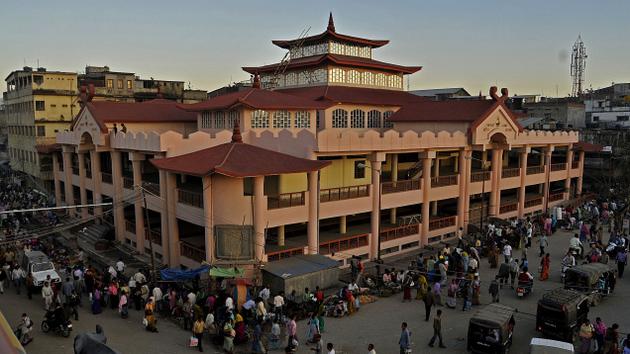A chubby faced Ima in the Imphal’s sprawling Ima’s market was talking in sing song Hindi and insisting me to buy her traditional Manipuri shawl. By then I had spent all cash I had with me and I chose to quickly drift through this group of sharp eyed Imas’ calling out from beside their towering stacks of handicraft products and shawls. From there I landed up in another cacophonous section of this one of its kind ‘all women’s market’, devoted to fresh produce. The section was filled with aroma of the freshly procured, fertilizer free, mostly organic produces. It’s a colour on display; the bright orange of oranges, the dangerous red of the famed killer chilli of North East and the lavish green of the pineapple, joined by beautifully scattered yellows, umbers, shades of blues and greens and delicate pink of lotus flowers.
My friend and guide Ryen, explained me that slots in these markets are handed down through generations to generations and are religiously hold onto. I sauntered my way to another section dedicated to earthen products – from decorative to household stuff, all were arranged meticulously as a display of culture – in both material and the less tangible kind. Out in this kaleidoscopic display of colours, the only thing that didn’t fit was the presence of commandoes in their olive green. To me it seemed to have merged with the daily life of a commoner, yet silently echoing as a dirge.

An Ima (in manipuri language ‘Mother’) selling earthen pots in the market. (pic by Bijoyeta Das, taken from – dw.de
The thrum of crowd and traffic on the road give Imphal a look like of any metropolis, the center point is crowded and a hub of all activities. But as you take your way back through side lanes, the real Imphal emerges. Ryen pointed out at small joints, rather homes, where traditional Manipuri rice beer was getting brewed. Manipur’s tribal communities have not been prohibited from brewing liquor in this dry state; in the evenings these verandahs are lit with lights or candles and laid out with drinks.
 Sauntering through these lanes, looking at the hills that extend upto Myanmar, one can still feel the vibes of war of 1944, when the Indian National Army (backs by the army of Japan) advanced during WWII and a war was waged between the British and the INA. Wars are still fought today on this picturesque valley, though smaller, messier and long drawn. As a testimony to these war stories, hidden in the calmness of the valley, stand two reverie inducing war cemeteries, lined by weeping willows, housing memorials of these brave souls. The most tangible remaining mark of the war is in the British built metallic road that leads you out from Imphal to Moraing, the same place where the INA had laid siege and planted the Indian tricolor and named the spot ‘Azad Hill’. Ryen directed me to a statue with a peaked cap ‘Bose’ he exclaimed with a hint of pride in his voice. I was at the INA museum. Ryen told me that INA had distributed pamphlets in Moraing seeking help for the soldiers; many locals including his grandpa were arrested and consigned to an underground prison by the British for helping the INA. But it wasn’t the first time Manipur had resisted the British, he recalled the Anglo-Manipur war of 1891; the heroes are still remembered, honoured and ballads in their praise are still sung. Ryen was eagerly sharing stories of the tumultuous past of Manipur and it was startling for me to see how these war stories have developed an organic connection with the life lived here. Manipuris are proud of their past, they nurture it and stories go down from one generation to the other. It was interesting to hear from Ryen, belonging to Gen X of Imphal, talk of Anglo-Burmese war, the controversial Kabaw valley and redrawing of Manipur’s map; stories from the 19th century.
Sauntering through these lanes, looking at the hills that extend upto Myanmar, one can still feel the vibes of war of 1944, when the Indian National Army (backs by the army of Japan) advanced during WWII and a war was waged between the British and the INA. Wars are still fought today on this picturesque valley, though smaller, messier and long drawn. As a testimony to these war stories, hidden in the calmness of the valley, stand two reverie inducing war cemeteries, lined by weeping willows, housing memorials of these brave souls. The most tangible remaining mark of the war is in the British built metallic road that leads you out from Imphal to Moraing, the same place where the INA had laid siege and planted the Indian tricolor and named the spot ‘Azad Hill’. Ryen directed me to a statue with a peaked cap ‘Bose’ he exclaimed with a hint of pride in his voice. I was at the INA museum. Ryen told me that INA had distributed pamphlets in Moraing seeking help for the soldiers; many locals including his grandpa were arrested and consigned to an underground prison by the British for helping the INA. But it wasn’t the first time Manipur had resisted the British, he recalled the Anglo-Manipur war of 1891; the heroes are still remembered, honoured and ballads in their praise are still sung. Ryen was eagerly sharing stories of the tumultuous past of Manipur and it was startling for me to see how these war stories have developed an organic connection with the life lived here. Manipuris are proud of their past, they nurture it and stories go down from one generation to the other. It was interesting to hear from Ryen, belonging to Gen X of Imphal, talk of Anglo-Burmese war, the controversial Kabaw valley and redrawing of Manipur’s map; stories from the 19th century.
Ryen had decided to enrich me with Manipuri history that day. Our next hop was the Kangla Fort, where the kings of Manipur were coranated and lived. Though in ruins, Kangla fort still stands as a reminiscent of the mighty empire that remained undefeatable for centuries. The grassy grounds and splendid outer and inner moat, royal enclosures, relics of a temple, and a glassy hijagang or the boat shed to house the serpent headed royal boats hiyang; make this fort quite a visit. And add to it, quick quips of history from a history buff local. And for more dose of history, one can take a turn to state museum and take a look at paintings depicting Manipuri royal history, intricate Manipuri jewelry, costumes and weapons.

Kangla fort still stands as a reminiscent of the mighty empire that remained undefeatable for centuries.
I was willing to go on and explore Imphal and feel the strong affinity between history, culture and life that exists here; but to keep a Manipuri away from food for such a long time is a sin. Ryen took me to his home, saying that he wanted me to taste the best food in Imphal. Water based food is intrinsic to Meitei culture; one can see that in the preponderance of fish and water rich vegetables in food and its obsession with rice. Ryen had cautioned me of the walking ghost or Bhoot Jalokia or Naga Mirch. In Manipur, they call it u-morok and seasoned travelers share stories of their first encounter with it. The chilli is available in entire North East but celebrated the most in Manipur. You can’t visit Manipur and give u-morok a miss. It is used in curries, in flavoring fish, pickeled and chopped finely to have as fritters. And you can feel it explode in your mouth, and for a minute you lose your senses. Ryen’s mother brought for us a famed household dish of Manipur – Iromba, a thick mish mash of boiled vegetables, onion stalks stir fried with shrimps, and dried fish with chopped u-morok frittered over it and a mountain of rice. A small spoonful of the dish and you can feel the fish-chilli combination travel down your throat, defying all biochemics of taste-buds. My host nodded sagely as I savoured the chilliest dish I had ever had. And Ryen was teasingly smiling. But it was sumptuous with the least trace of oil imaginable.
He had promised to take me to the oldest Polo ground in the world. Looking at the empty stretch of the playground, he shared the story of origin of Polo. It is Manipuri invention and considered a God’s game, and when British saw the locals playing it, they remodeled it and christened it as polo and popularized it.
We were back by evening to our hotel – The Classic, to me town’s best hotel and to Ryen the only hotel in Imphal and made our way straight to the Rita Café to relax our weary shoulders while sipping on its celebrated Italian smooch mocktail. As the night approached, I looked at this beautiful land of blue-green hills, cascading rapids, carpet of flowers and a land where faith, tradition and life seem to flow into each other organically. Here history is lived like fiction and reality appears a myth.
To reach
The easiest way is to take a flight to Imphal, else one can take a train upto Dimapur and can then take a cab or bus to Imphal. While crossing Nagaland, one would be asked to show a certificate of nationality.
Where to stay
There are modest points of accommodation scattered over the city, but for a comfortable and safe stay chose Hotel Classic.
To eat
Hotel Classic’s Rita café is a ‘to go’ destination to relish your appetite and for nice mocktails. Otherwise Hotel Chak is another spot for some great local taste. Smaller outlets in the Paona Bazaar are all ideal points for nice eatouts; food in most of these places would be authentic Manipuri with a richness of fish.
To buy
Manipuri is famous for jewelry. It’s good and cheap and dominates the markets of Shillong and Kohima. Apart local handcraft and especially the paper dolls, modelled on the tribes of Manipur are unique souvenirs to take home.











A very informative post. Nice narrative too .
Thanks Priyanka. NorthEast India is a truly a paradise unexplored.
I agree totally. I have been waiting to visit the North east for far too long. The urge gets stronger when I read posts like yours. I hope this year sees that wish fulfilled,
I pray so.